New Orleans Gumbo with Shrimp and Sausage
My take on a hearty New Orleans Gumbo with shrimp and sausage! I’m making the roux from scratch so it’s extra flavorful! This recipe is perfect to make on the weekend and enjoy all week long as the flavor gets BETTER with time!

A biiiig ol’ pot of steaming hot New Orleans style GUMBO right here.
Talk about this being the highlight of the week! A big pot of gumbo with shrimp, sausage, and if you’re feeling extra generous, some chicken! I love making these kinds of meals on a Sunday. It’s hearty and cozy and the leftovers are enjoyed for a quick lunch all week long. Just think – a warm bowl of rice topped with a slow-simmered, tomato-based stew loaded with aromatics like onions, peppers, and celery. It’s spicy, hearty, and completely made-from-scratch. Okay, it’s basically amazing. I don’t know about you, but I LIVE for food like this.
This is for my food lovers out there that don’t mind taking a few extra minutes to make GOOD FOOD. It’s perfect to curl up with on the couch. If you’re in Texas, have the air conditioner on full blast while you pretend isn’t just shy of reading 1000 degrees. And if it happens to be cool when you’re making this, I promise you it will warm you to your bones!
Let me just say it now, THIS is a LOOOOOONG post. If you are a gumbo expert and just want a recipe, feel free to scroll to the bottom. I’m sharing all the things I’ve learned from when I was a noob.
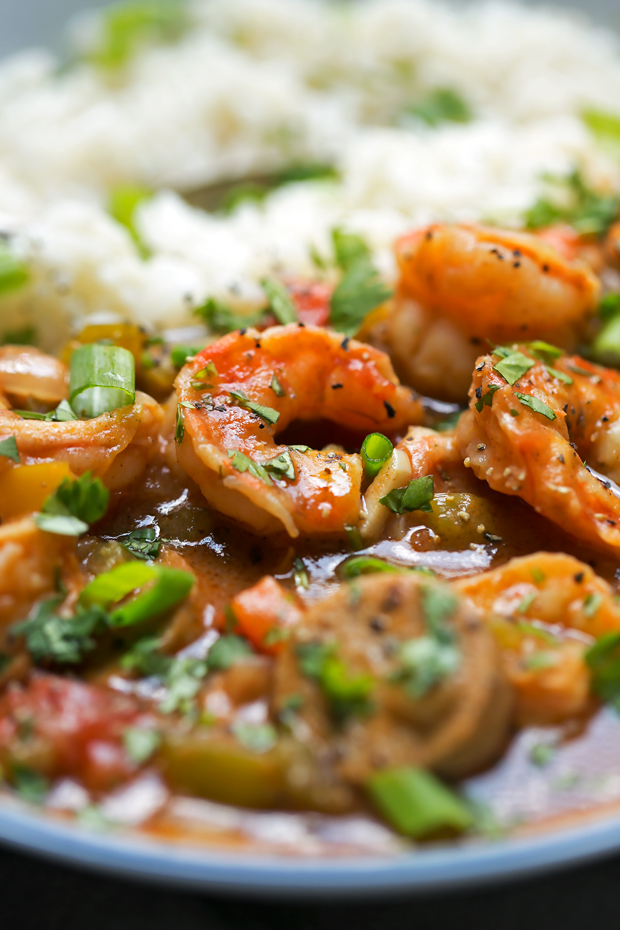
While this was still in the recipe testing phase, I read pretty much everything on the topic. Not to mention the countless videos I sat through to make sure I learned how to make a proper roux. And though I’m not claiming I’m an expert in gumbo making or that my recipe is an authentic ‘Creole’ or ‘Cajun’ recipe, I will say I’ve picked up quite a few things along the way that can help make your pot more delicious.
Best tips for making the best gumbo:
- The cookware: The roux in this recipe requires extra special love and care and so I really suggest using a dutch oven or a heavy bottom pot. A pot that’s pretty thin, like a stockpot is not a good option for this recipe. Stockpots get super hot and you run the risk of burning the roux. But you could make the roux in a cast iron skillet, then transfer to a stock pot and continue from there.
- The Mise En Place: Basically all I’m saying is that just get your ingredients ready to go! Chopping while browning the roux is a big no-no. I highly, highly, highly suggest getting the chopping, measuring, and having all ingredients ready to go before you start making the roux. Trust me on this, it will make your life so much easier.
The secret to making the perfect roux for homemade gumbo recipe:
What is roux?
It’s basically the heart and soul of every gumbo recipe. I’ll elaborate further It’s a simple combination of oil and flour that is slowly browned to perfection. You want a nice, deep, and rich flavor that gumbo is known for. In our case, we’re using equal parts of each.
- A high heat oil. You can use corn, avocado, canola, or vegetable. I don’t suggest using olive, coconut, or any other oil that has a low smoke point. You need something that can really withstand the heat and the longer cooking time.
- All-purpose flour. I’ve only tested this recipe with all-purpose flour so sadly, I can’t say if any other type will work.
- Continuously stirring: I know, I’m asking a lot here! Okay, so yes, this needs a total of 15-20 minutes of constant stirring and constant attention. And yes, I’m asking you to drop everything. No multitasking in general but a big pot of gumbo is in your future and I promise you, you will love me a little more when you don’t have a burnt, smelly pot of caked-on flour to clean because like a champ, you listened and babied your roux.
Know the stages of a roux:
Okay. So now that I’ve stressed the importance of constant stirring and no daydreaming while roux-making, let me walk you through what to expect in terms of the roux. The timing may vary 1-2 minutes but this is a guideline to help you make sure you’re on the right track. If at any point your roux is browning too much/too little, adjust the heat slightly to help it get back on track.
- The blond roux: This is the most basic type of roux that we make. It’s what you make when preparing a béchamel sauce and it’s also what we use to make my shrimp enchiladas with poblano cream sauce. The roux is nice and light and usually requires just a quick 30 seconds -1 minute of browning the flour.
- 5-minute roux: This reminds me of the color of tahini paste. It’ll be a little deeper than the blond roux but we need to keep going. Keep in mind, as we cook the roux, it is losing its thickening power. This means that the darker the roux, the less it will thicken your gumbo.
- 10-minute roux: Almond butter-ish. It’s lighter than peanut butter but on its way there. You’ll notice that it smells a little like popcorn or similar to when you brown butter. A nice nutty smell.
- 15-22 minute roux: The color of homemade peanut butter. It’s dark and nutty and its a medium brown tone. I stopped my roux here (at 21 minutes exactly) because I still wanted a little thickness to the gumbo and a deep-dark roux is an acquired taste. If you’re new to gumbo making, i’d suggest leaving it at this stage! It will thicken the dish just enough and the flavor will be well pronounced without overpowering.
- 25+ minute roux: Dark brown roux is the color of peanut butter. You can take the roux a little further to what is considered a black roux (about 32-40 minutes), which is about the color of dark chocolate. But keep in mind that this will change the overall taste of dish and will leave it thin (a soup like consistency) and a black roux just isn’t for everyone!
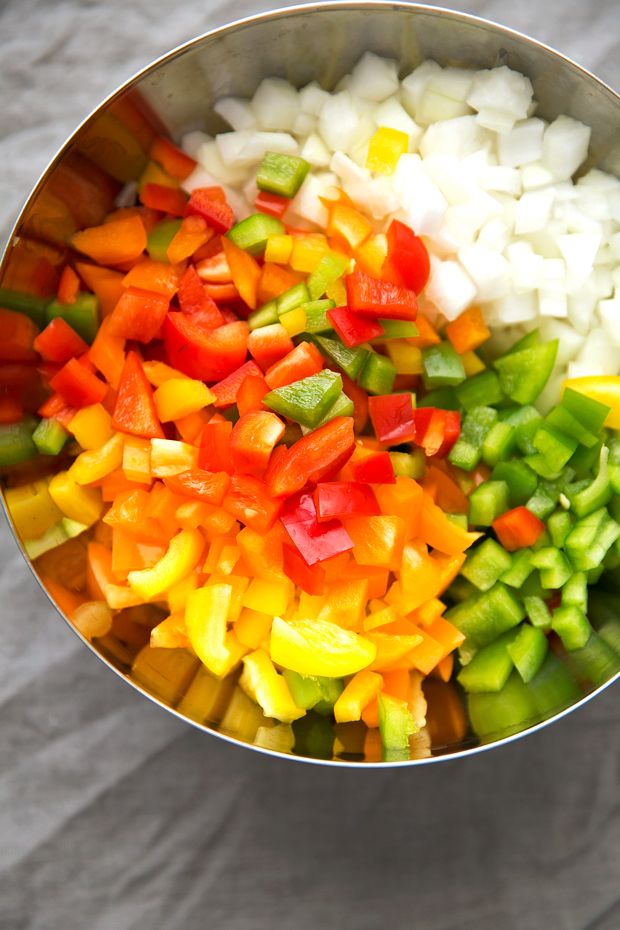
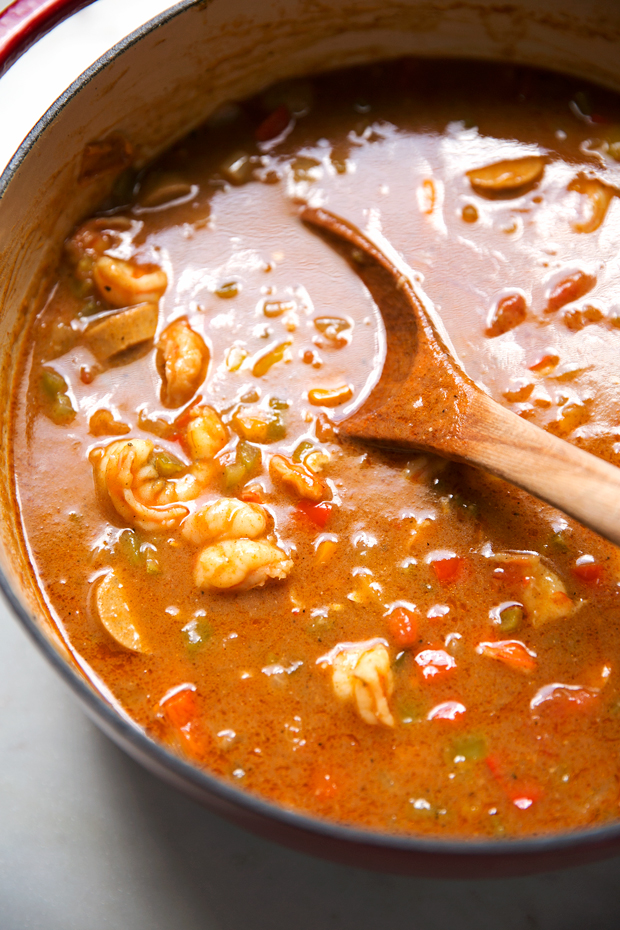
Basic ingredients in gumbo:
- Oil: Is one of the two ingredients needed to make the roux.
- All-purpose flour: Is the other ingredient need to prepare the roux. It’s the first step of making gumbo.
- The holy trinity: This is a combination of yellow onions, celery, and bell peppers. Keep in mind that I used a colorful array of peppers, however, just green bell peppers would also work for this recipe
- Garlic: you can use as much or as little as you like, I use 6 cloves for that perfect flavor!
- Bay Leaves:
- Sausage: Andouille sausage is most commonly used when making gumbo. I
- Seasonings: You’ll need cajun or creole seasoning, Louisiana hot sauce, and cayenne pepper to add some heat.
- Tomatoes:
- Chicken broth: we’ll need a quart. Homemade chicken stock is best because it allows you to control the sodium in the recipe. But you can also use a carton of store-bought or dissolve a few cubes of bouillon in water and use that.
- Shrimp: I like to use shrimp in my homemade gumbo but I have seen all sorts of other additions like oysters and crab legs in a seafood gumbo.
- Filé Powder: or gumbo filé as it’s sometimes called is a spicy herb made from dried and ground sassafras leaves.
- Ingrdients for serving: I like to have some chopped scallions and fluffy white rice to serve. Gumbo can also be served in a bowl like a soup.
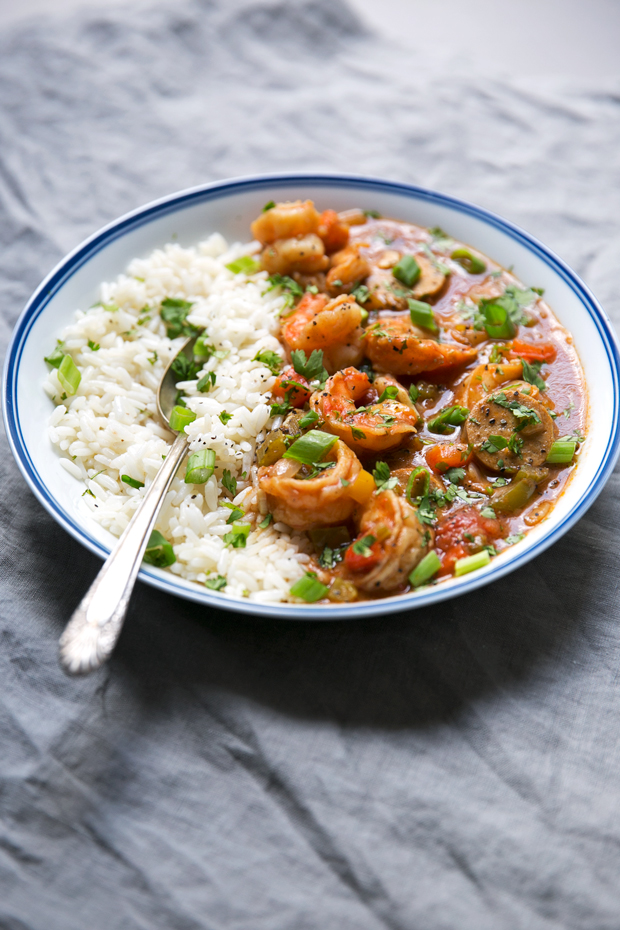
You’re still here! I was afraid I might have scared you off! Honestly, it’s not difficult to make, it just requires some attention. After you make it for the first time, you’ll be able to tell exactly how long it takes to get your roux to that perfect sweet spot. From then on making gumbo will be a breeze. Possibly even a midweek affair?
Oh, two more things! My recipe uses stewed tomatoes, if you can’t find stewed tomatoes, diced tomatoes can be used. Also, some people don’t believe in adding tomatoes to their gumbo recipe and I’m actually loving the way that tomatoes taste in this! Authentic or not, it’s delicious! I also chose not to use okra in this recipe, as I’m not the biggest fan of it. I’m a texture girl and something about it just doesn’t sit right with me.
A pot full of this stuff was slow simmering last Friday, all morning long. For lunch, hubby and I ate like king and queen. A bowlful of this stuff really made me miss the short time we spent in the French Quarter a couple of years back. I didn’t even have to call when lunch was ready, the smell of slow-simmered, home-cooked stews have their way of getting everyone together at the table.
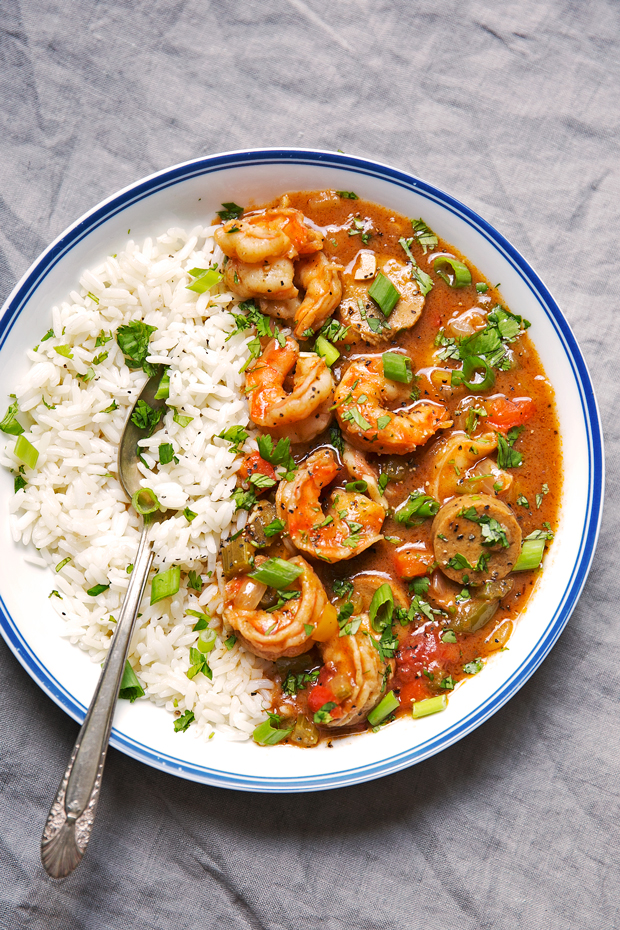
shop the post:
[show_shopthepost_widget id=”3114030″]
New Orleans Gumbo with Shrimp and Sausage
My take on a hearty New Orleans Gumbo with shrimp and sausage! I'm making the roux from scratch so it's extra flavorful! This recipe is perfect to make on the weekend and enjoy all week long as the flavor gets BETTER with time! I highly suggest reading the post once all the way through before starting the recipe. I provide lots of tips to get the perfect roux color which will help make this process much easier.

Ingredients
roux:
- ½ cup high heat oil, such as canola, corn, or vegetable
- ½ cup all purpose flour
gumbo:
- 1 medium onion, diced
- 2 bell peppers (I used ½ of each red, green, yellow, orange - see note), diced
- 3 stalks celery, diced
- 6 cloves garlic, minced
- 3 bay leaves
- 8 ounces andouille sausage, sliced (I used Tofurky)
- 2 tablespoons EACH: cajun seasoning AND tabasco sauce (more or less to taste)
- 1 tablespoon cayenne (omit if you want it mild)
- 4 cups low sodium chicken broth
- 1 (14.5 ounce can) stewed tomatoes and juices, roughly diced
- 1 ½ pounds raw shrimp
- 2 teaspoons gumbo filé
- sliced scallions + white rice or quinoa, for serving
Instructions
ROUX:
- Heat the oil in a large dutch oven or a heavy bottom pot over medium-high heat. Whisk in the flour until combined and smooth. Switch to a wooden spoon and continuously stir for 15-22 minutes or until the roux darkens to just past a deep peanut butter color. Do not let the roux burn! (if you smell it burning, you will need to throw is out, clean the pot, and start over, unfortunately there's just no saving burnt roux!)
- Once the roux reaches that deep rich brown color, stir in the onions, bell peppers, and celery and continue to cook, stirring as needed so the vegetables don't stick. About 8-10 minutes or until the veggies soften. Add the garlic, andouille sausage (if using tofurky, do not add yet), and bay leaves. Continue to cook for an additional 1-2 minutes until the garlic is nice and fragrant.
- Add the cajun seasoning, tabasco sauce, and cayenne along with the chicken broth and stewed tomatoes and bring to a high simmer before lowering the heat to medium-low, covering and simmering for 15-20 minutes.
- IF USING TOFURKY: Add a teaspoon of oil to a skillet over medium high heat. Add the slices and cook for a quick 90 seconds (turning half way) just to sear the outside before adding to the gumbo.
- Add the shrimp and tofurky (if using) to the gumbo, give it a stir and allow to continue to simmer for an additional 10-15 minutes or until the shrimp is opaque and the veggies have softened. Taste and season with salt and pepper as desired. Add the gumbo filé and stir. Remove bay leaves before serving.
- TO SERVE: Serve warm with white rice or quinoa with sliced scallions on top.
Notes
- You don't have to use all the colors for the bell peppers. I just really enjoy the taste that they bring to the party! You can use 1 green and 1 red bell pepper and still achieve a similar flavor.
- Tofurky is a sausage that's completely meatless. You can use the Andouille variety, which is a little difficult to find or the Kielbasa which most grocery stores carry.
- 1 (14.5-ounce can) diced tomatoes can be used in place of the stewed tomatoes as they can be hard to find sometimes.
- Gumbo filé - available in the ethnic food aisle near where they keep the cajun seasonings. It's basically ground leaves from the sassafras tree.
- Also, please keep in mind that this recipe has not been tested with any other ingredients than what is written. For best results, I suggest following the recipe as is (with the exception of spices to taste).


I just made this…YUMMY!! It’s the first gumbo recipe that I really liked. I couldn’t find file, I used beef andouille and “Slap Ya Mama Cajun Seasoning” (It comes in Original & Hot Blend, I used the original). I will make this again!
I’ve heard soooo many people say that seasoning is great, i’ll have to give it a try! Happy to hear you enjoyed it, thanks Janis!
“Slap Ya Mama” Seasoning was great in it- if you love HEAT! Which I do… but I think when I make it again, I will either omit the cayenne or cut the “Slap ya Mama” in half. It was delicious but I was having to put my bowl down every other bite to give my mouth a moment to cool down. 5 Stars for this recipe though!
IF USING TOFURKY: add a teaspoon of oil to a skillet over medium high heat. Add the slices and cook for a quick 90 minutes (turning half way) just to sear the outside before adding to the gumbo.
Is it really 90 minutes or is it a typo? Just wondering I can’t wait to try and make this gumbo, it looks delicious thank you so much for your recipe
Sincerely a fan
Omg! Yes, definitely a typo. It’s 90 seconds! Thanks for catching that. Hope you enjoy the gumbo 🙂
If I want to let this simmer all day to develop the flavors, do I add everything except the shrimp? I do not cook much but I am learning!!
Yes, everything but the shrimp and i’d let it simmer on low rather than medium-low. Also, keep an eye on the consistency, if it starts getting too thick, you made need to add a little water to get it back to a stew-like consistency! 🙂
This looks delicious and I appreciate the sharing, however I’d like to add that Gumbo is described as “everything that’s good from the Gulf” for a reason. Shrimp is a standard ingredient. If your gumbo doesn’t have shrimp, it isn’t gumbo.
Can you use shrimp stock instead of chicken stock
absolutely!
YUMMY!!! Thank you for sharing this wonderful recipe! It is full of flavor and was a huge hit at dinner time!!
So glad to hear it! Thank you for taking the time to comment 🙂
Your recipe sounds yummy, but I have to point out that in order for a Gumbo to be Gumbo, it has to have orka in it.
Hi Jean,
I made this and I like you believe Gumbo should have Okra. I added it to mine and it still turned out very good!
My husband is a big fan of it!
Made it!! Super yummy!!
I am making this now If i wanted to make it larger would i just add to the trinity
Hi Clinton! If you wanted to make a larger batch, I suggest increasing all the ingredients. You can multiply the quantities by 1.25, 1.5 or simply doubling everything in the recipe if you need to serve a crowd. I don’t suggest just adding to the holy trinity ingredients as this would significantly change the recipe.
Made this yesterday and it was a big hit!!!!
This is definitely yummy goodness! Especially with snow outside
Flavor was great no salt needed. We like mushrooms so I added a few for what tha heck. I could have had it a little thicker so next time I will try more roux.
Used this recipe to make gumbo for the first time ever! I wish I had fresh shrimp to use in it, but that wasn’t an option at my store, so I had to use pre-cooked frozen shrimp (the kind the have for shrimp cocktails) and those actually worked really well and still tasted great. I cooked the roux for 20+ minutes, and it turned out a little darker than I would have liked. Not sure if I did it wrong, but it had a very strong over powering flavor. It was a nice red color though. All things considered it was still a delicious meal! Thanks for the detailed instructions!
Wow amazing I will be putting this in my cook book to make on a regular basis thank you very much <3
This was amazing. My hubby had Gumbo at Cheesecake Factory and I loved it so much I wanted to try and make it. I found your recipe and my hubby thought your recipe was even better than the restaurants. Thanks so much.
So glad to hear that it was a hit! Thank you for taking the time to comment! 🙂
I collect Cajun recipes and have a cook book called River Road from La. It has the best Shrimp Creole recipe I have ever tasted. For an extremely tasty rioux try using bacon grease. Not the healthiest one to use but the taste is worth an occasional use of bacon grease. Has anyone ever tried making this with chicken instead of shrimp and if so did it turn out good. Used to live on coast and thoroughly enjoyed all types of seafood but have developed an allergy that can kill me so I have to find substitutes. Sometimes still use my shrimp creole recipe but use chicken and it’s good, its just not shrimp.
Thanks for your input Margaret! I’ve tested the recipe with shrimp + chicken before and we really enjoyed it that way too. I would suggest pan frying the chicken until its about half way cooked through and adding it to the gumbo towards the end. Oh, also, I seasoned the chicken with an extra pinch of cajun seasoning so it had some flavor. Hope you enjoy it!
Congratulations on making your first gumbo! Im a New Orleans native and if you can make a gumbo from scratch you are a pretty good cook! Id just like to say from the looks of the pictures and the recipe I think you would really enjoy shrimp etouffee since you included tomatoes and made it more of a red gravy instead of the usual brown gravy!
Loved this blog and all of the extra info for making this gumbo. It’s 12midnight and I plan to buy the ingredients tomorrow so that I can make it within the next couple of days. I am a pretty good cook and love all of the ingredients in this recipe. I’ll let you know how it turns out.
After reviewing many gumbo recipes, I’m happy to say I hit the jackpot when I used this recipe. The result was so delicious. I browned 3 chicken thighs, which I shredded at the end of cook time. I used fresh tomatoes from the garden and added fresh okra from the farmers market. Definitely a keeper!
I made this today and it was my first time making gumbo, and the recipe was very easy to follow. My family loved it!! Next time I am going to add okra and chicken.
I don’t use file as it doesn’t reheat well, tends to make the gumbo gummy. I use roux and okra for thickening
As someone from Louisiana who learned to make gumbo from a few older ladies who’ve lived there their whole lives I’m impressed! Most “gumbo” recipes aren’t gumbo at all! My only recommendation is the best Cajun seasoning there is and the only one most Louisiana residents use is Tony Chachere’s. You won’t need the extra hot sauce if you use Tony’s. It gives you a flavor heat instead of just a spicy heat. I usually add chicken to mine, but really you can do any meat you desire. One of the best I ever ate had fresh blue crab I it. And okra is definitely optional since it’s not for everyone!
I made this last night and it was *killer*! I think it gave me street cred as a cook among my family. I used butter instead of oil for the roux and as an okra lover, used okra instead of tomatoes since you said they were optional. So good. Next time I might use both tomato and okra. Question about the file- I bought and used, but had never heard of it. Does it give flavor? Or texture?
That’s awesome! File is used in gumbo recipes to give it an earthy flavor and help thicken it (although I don’t think our tiny amount is actually doing much thickening). Glad you’ll be giving it a go with the tomatoes next time! 🙂
I’m happy to come across your gumbo recipe, just made it this morning. My husband loves it that he ate 2 bowls for early lunch :), will be making it again.
So glad to hear that Jo-Ann! Thank you for taking the time to come back and comment! 🙂
Hi Marzia. Thank you for taking time to reply and for this recipe. I have made this gumbo recipe twice again. My husband came down with a cold yesterday and requested this recipe for his comfort food.
Excellent….we absolutely loved it
Loved it but got to have the okra
Absolutely ?
OMG! I freaking LOVE Gumbo! This is the very first time I made Gumbo and I stumbled upon your assistance and NAILED it! Thank you so much Spice in a Jar! (Insert hand clapping with standing ovation).
Fellow Gumbo friends… follow your pallet with these amazing directions.
Exquisite Roux directions. Follow, Follow, Follow!
I am very impressed.
Happy New Year!
I could only find frozen ready to cook raw shrimp – if this ok to use? So excited to try and make it.
Yes, that’s fine! I just suggest that you allow them to thaw before using them in the gumbo.
Absolutely awesome! This is definitely a keeper. In the middle of an arctic blast in Michigan right now so this was an awesome find!
Thanks for sharing.
Made the gumbo for my husband and daughter and they love it. My daughter took the leftovers to work and everyone there loved it I had to rewrite the recipe for them and my daughter copied it for the rest. One of the employees made it for his wife but instead of putting the tobasco sauce in it they put it in themselves individually his wife doesn’t do spicy. Thanks for the recipe